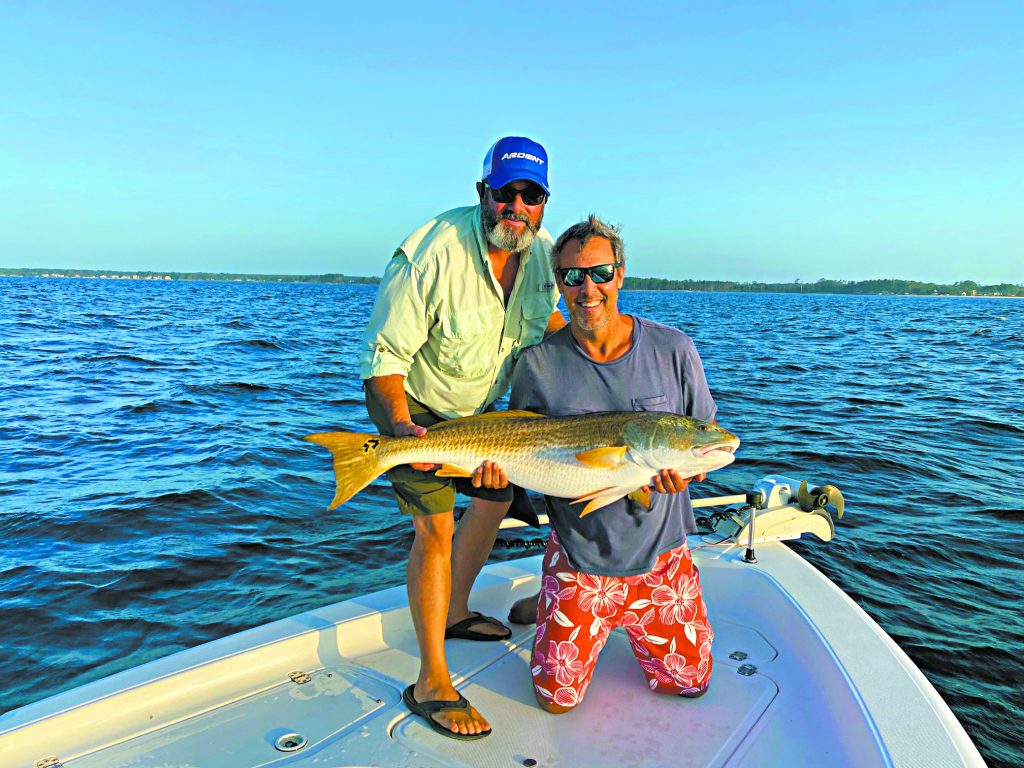Tidelines – October 2020
Every September calls for at least one citation red drum trip in the Neuse/Pamlico, and this year it was Capt. Jeff Koen, of Salt and Swamp Guide Service, that agreed to meet at the Oriental town docks by The Bean coffee shop for a half day of throwing popping corks in search of these trophy fish.
Jeff had been having most of his success in the days leading up to our trip by targeting 16-18’ of water, but the game when hunting the big red drum is always about bait. Find the bait, and typically you find the fish.
One of the more popular fishing spots is “The Diamond,” a spot out near Orchard Creek and Gum Thicket. As we made our way into the Neuse River, we saw a handful of boats heading that way in the early morning light; however, there had been a lot of boating and fishing traffic recently, and Jeff’s friend, who had been fishing there the past couple of days, had informed him the night before that he hadn’t seen any fish or any bait for a couple of days. Jeff made the call to try a spot in a different direction out of Oriental.
-

Capt Jeff Koen (left), of Salt and Swamp Guide Service, guided Gary Hurley to his first Neuse River citation red drum of the 2020 season. The red was caught near Oriental on a popping cork rig in 16′ of water.
“These fish are wary,” Jeff shared as he came up to our first spot and started searching both the water’s surface and the machine for signs of bait. “They don’t like motor noise, somebody stomping on the boat, or slamming a lid. Anything that can sound different than bait noise hitting the surface is usually viewed by them as danger and they will go away from it.”
Our spot sat over some oyster rocks and in the 16-18’ of water that Jeff was recently liking. He also had noted in the previous week that a lot of bait had been both holding and moving through this area, and while no bait was visible to the eye, the machine saw plenty.
Jeff explained, “You get on these oyster rocks around the full moon and there should be more fish on those areas. The red drum like to spawn on rocks, and it’s time to spawn on the full moon.”
He handed me a Hanta Hybrid 80 S rod, a rod he specifically likes because of its ability to cast long distances even when using heavy terminal tackle (such as beefed-up popping cork rigs). Tied under the popping cork was a fluoro leader and then a 6” soft plastic swimbait that I didn’t recognize.
“I’m using a 33-inch leader instead of a 26-inch leader these days,” he informed as he kept his eyes more on the machine than on the water’s surface. “I’ve found that 33 inches is just what’s working better right now. You have to experiment to see where the bite is, and this past week it’s been a longer leader.”
When I asked about the soft plastic, Jeff continued to explain how every decision he makes when targeting big red drum is deliberate, “I just think the fish see the same thing under corks constantly out here, so I like to throw something different.”
Though the wind was only blowing 7-10 mph out of the west, the waves were up a little out in the open water. Jeff instructed that waves meant we had to make a more significant cast and a more significant pop with our corks.
He likes a big long cast because the sound of the waves lapping against the boat can be a variable that works against success. Sure, sometimes those big reds will bite right next to the boat, but on days with wave noise, he likes to distance the baits from the boat.
On the popping action, he wanted me to make a significant pop and then let my bait sit for 8-10 seconds before popping again.
“There are a lot of people that pop a lot and move the bait very fast,” he explained as I began the pop and wait action that he instructed. “My philosophy is that it’s like ringing a dinner bell when you make that pop. You got to give them time to get to that bait, especially if you’re fishing deep water. You’re trying to ring them up from 15-foot deep, so you got to give them time to get there.”
Only 15 minutes into our wind drift, my cork suddenly but quietly disappeared. I had been watching, so I just as quickly reeled tight and then set the hook on my first Neuse River citation red of the 2020 season.
The routine was a big landing net, a quick photo, a fast measurement, and a careful release to make sure my big red was ready to swim off.
Capt. Jeff Koen targets these big reds every year from mid-August into early October. He finishes the fall by targeting slot reds, trout, and flounder, and then by November his focus moves to guiding winter duck hunting trips. The spring brings him back to fishing, where the main target is typically stripers in the Pamlico, Neuse and Tar rivers.
You can find out more about the very methodical and deliberate Capt. Jeff Koen, of Salt and Swamp Guide Service, by visiting him online at www.fishingguidenorthcarolina.com, or by calling him at (252) 864-6693.
My suggestion is to ring the dinner bell and then wait—no matter how hungry you are, unless you’re a teenager or younger, it’s going to take you a little bit of time to make it to the table.





